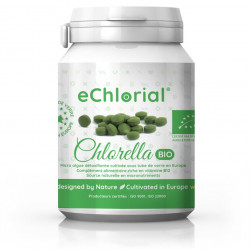The health of our intestinal flora or microbiota depends on our well-being!
Recent discoveries about the intestinal microbiota are as important as those about stem cells! They offer the possibility of early detection of serious pathologies, and give us a glimpse of new therapies for diseases that have a major impact on today’s society, such as obesity, type 2 diabetes, cardiovascular diseases, neurodegenerative diseases (Alzheimer’s, Parkinson’s, etc.), etc.

To maintain our intestinal microbiota, we recommend regular consumption of probiotics and prebiotics. Probiotics are composed of species of bacteria that should arrive alive in our intestine. Prebiotics are the food of the bacteria living in our intestine. To keep them active and allow them to develop, our diet must be sufficiently rich in prebiotics.
Today, the benefits of probiotics are somewhat disparaged (1), but the benefits of prebiotics are beyond doubt!
Prebiotics are mainly dietary fibers, preferably found in plants… but also in certain algae such as chlorella!
Chlorella is already well known for solving constipation problems. Its effects on the intestine are immediate and felt from the very first dose.
Chlorella’s prebiotics may well be part of the reason for its fast-acting effects on our well-being.
Prebiotics protect our intestinal microbiota
Summary of what we know about prebiotics :
Desearchers (2) have discovered that prebiotics (a type of dietary fiber) can modify over a hundred bacteria in the intestinal microbiota of obese and type 2 diabetic animals. They showed that some of these bacteria are involved in dialogues between hormones produced by the gut and key organs such as the brain, pancreas and adipose tissue.
For example, the expression of leptin, a hormone associated with the improvement of type 2 diabetes, is thought to be reactivated by prebiotics.
The value of prebiotics in preserving the gut immune barrier has been demonstrated (3), as has their impact on appetite control and weight management (4).
Studies have shown that certain prebiotics can reduce insulin, triglyceride and cholesterol levels in obese people.
The intestinal microbiota
And yes, let’s face it: we are vehicles for bacterial colonies, without which we couldn’t live, and the quality of these colonies will determine our health and well-being as a whole!
We are home to thousands of micro-organisms, most of which are useful and even indispensable to us. A large proportion of these micro-organisms are bacteria that live in our intestines, they make up our intestinal microbiota or gut flora.
→ See also our article “Our intestines think with 200 million neurons” ( Arté report)
The intestine is full of nerve endings that communicate with the brain!
Doctors speak of an ” intestine-brain axis “. It has now been demonstrated that intestinal bacteria play a major role in establishing this link. They may be involved in central nervous system disorders, such as anxiety, depression and autism. They play an important role in diseases such as obesity and its consequences, including heart disease and type 2 diabetes.
Intestinal bacteria influence autoimmune diseases, which suffer from a serious disorder of gut-brain communication. They are implicated in inflammatory diseases of the joints (arthritis) and intestine, and in colon cancer.
We now know for certain that the composition of our intestinal flora (gut microbiota) influences the development of many health problems.
These discoveries about the intestinal microbiota are full of hope: that of discovering “new bacteria” and the means to encourage their development, capable of having a positive impact on the organism, where current therapeutic means are unsuccessful.
Why protect our intestinal microbiota?
Our health and quality of life depend on the balance of our intestinal microbiota or intestinal flora!It’s made up of hundreds of species of bacteria living in symbiosis, each playing a specific role.
A varied intestinal flora is considered healthy. It must contain a sufficient number and quantity of beneficial species.
It has been shown that certain species of bacteria present in healthy people are absent from the intestinal microbiota of obese people.
How can we protect our intestinal microbiota?
We can act on our microbiota to encourage the development of beneficial bacteria and reduce that of harmful bacteria. To do this, we need to adopt a healthy lifestyle.
Exercise and a healthy diet will help maintain a varied and balanced intestinal flora.
Eat a healthy, varied diet
Each species of bacteria plays a different role in our health. Each requires specific nutrients for growth. That’s why it’s important to eat a healthy, varied diet.
Limiting the development of enemy bacteria
Sugars and fats should be reduced to avoid encouraging the development of pathogenic bacteria, yeast or fungi such as Candida. Artificial sweeteners such as aspartame should also be avoided.
Regular consumption of probiotics: bringing good bacteria to the intestine
Capsule probiotics: commercially available capsules usually contain a mixture of live micro-organisms, including several species such as lactobacilli and bifidobacteria.
Studies have shown that probiotics can help restore a disturbed microbiota.In recent years, probiotics have been the subject of controversy, as studies have not demonstrated that they are capable of permanently modifying the microbiota.
However, studies have shown that they can restore an unbalanced microbiota to a healthy one.
Probiotics in our diet: beneficial bacteria are present in fermented foods. They are absent from all pasteurized, sterilized or preservative-containing products.
We recommend regular consumption of fermented foods such as sauerkraut, yoghurt (5), kefir, etc.
Ensure that good bacteria arrive alive in the intestine
Taking probiotics is good, but allowing them to wait for their place of action is even better
Before reaching the intestine, a large number of ingested good bacteria will be destroyed, as they are sensitive to acidic environments. To encourage the survival of as many as possible, eating yoghurt will help, as it reduces stomach acidity.
Helping good bacteria to develop in the intestine
Prebiotics are the food of intestinal bacteria. They enable them to survive and develop. Prebiotics are mainly fibers (or complex carbohydrates) that are not transformed by our digestive system and arrive whole in the large intestine.
Numerous studies have shown that prebiotics promote the growth of healthy bacteria, particularly bifidobacteria.
The different species of bacteria making up our microbiota have their own nutrient requirements. So it’s important to eat a varied diet to ensure a good balance between colonies.
The fibers in our diet will help the survival and development of certain allied bacteria. They belong to the family of carbohydrates (sugars), some of which are complex.
Fibers are not digested by the body, but arrive unprocessed in the intestine.
Fiber is an important part of our diet, because in addition to nourishing certain beneficial bacteria, it plays a role in weight control. In fact, they reduce the absorption of fats and various sugars, thereby lowering their glycemic load. They also have a positive effect on satiety. We also know the importance of fiber in balancing intestinal transit and combating constipation.
Fiber-containing foods are mainly plant-based, and are found in fruit, vegetables, legumes and wholegrain cereals.
The daily fiber requirement per adult is around 30 g.
Some micro-algae contain prebiotics, as in the case of organic chlorella which contains between 10 and 20%!
Ultra-pure organic chlorella, grown in Europe

Trial offer ( 2 x 100g ) Premium Chlorella
58.00 €
49.00 €
